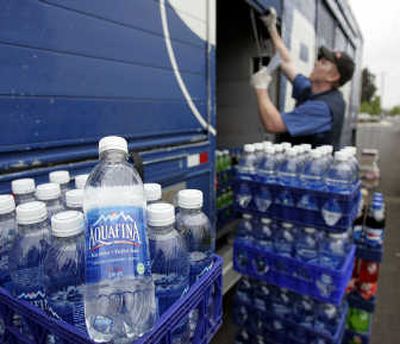A change on tap at Aquafina

NEW YORK — The label on Aquafina water bottles will soon be changed to spell out that the drink comes from the same source as tap water, the brand’s owner PepsiCo said Friday.
A group called Corporate Accountability International has been pressuring bottled water sellers to curb what it calls misleading marketing practices.
Aquafina is the single biggest bottled water brand, and its bottles are now labeled “P.W.S.” The new labels will spell out “public water source.”
“If this helps clarify the fact that the water originates from public sources, then it’s a reasonable thing to do,” PepsiCo spokeswoman Michelle Naughton said Friday.
The corporate accountability group is also pressing for similar concessions from The Coca-Cola Co., which owns the Dasani water brand, and Nestle Waters North America, seller of Nestle Pure Life purified drinking water, which gets some of its water from municipal sources.
Dasani’s Web site says that Dasani comes from local water supplies and is then filtered.
“We don’t believe that consumers are confused about the source of Dasani water,” Coca-Cola spokeswoman Diana Garza Ciarlante said. “The label clearly states that it is purified water.”
Sales of bottled water has been a growing source of revenue for companies such as PepsiCo Inc., based in Purchase, N.Y., and Atlanta-based Coca-Cola as they lessen their dependence on sales of traditional carbonated sodas, as consumer concern over health issues has weakened demand.
Nestle said Friday it has been printing new labels for its Pure Life water that say whether the water comes from municipal supplies or ground water, and the labels will begin showing up later this year. Pure Life is the only Nestle bottled water that uses public water sources and the company did not have an estimate for how much of its supply originates from the tap.
Wholesale sales of bottled water grew to $11 billion in 2006, according to the Beverage Marketing Corp., and the industry is expected to maintain growth rates of about 10 percent. The fastest growing segment of the industry is sales of bottles of less than 1.5 liters, which includes the individual serving sizes sold in many convenience and grocery stores.
The decisions by Nestle and PepsiCo come as criticism grows over environmental concerns about the industry’s use of local water sources as well as consumption of resin and energy to package and ship the bottles.
Last month alone, a barrage of news hit the industry: San Francisco Mayor Gavin Newsom banned city-funded purchases of bottled water; New York City launched an ad campaign called “Get Your Fill” to promote the benefits of tap water; and the U.S. Conference of Mayors adopted a resolution to bring attention to the importance of public water systems and the negative impact of bottled water.
“I think it’s unfortunate we have gotten into this tap water vs. bottled water debate,” the chief executive of the International Bottled Water Association, Joe Doss, said. “I do not think consumers are uniformly replacing tap water with bottled water.”